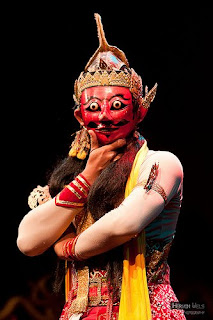Topeng dance (topeng is Indonesian for "mask") is a dramatic form of Indonesian dance in which one or more mask-wearing, ornately-costumed performers interpret traditional narratives concerning fabled kings, heroes and myths, accompanied by gamelan music. The form arose in the 15th century in Bali and Java where it remains prevalent, but it is also found in other Indonesian islands - such as Madura (near East Java). The well-developed topeng technique is now studied in universities of Europe and America.
Indonesian masked dance predates Hindu-Buddhist influences. Native Indonesian tribes still perform traditional masked-dances to represent nature, as the Hudoq dance of the Dayak people of Kalimantan- or to represent ancestor spirits. With the arrival of Hinduism in the archipelago, the Ramayana and Mahabharata epics began to be performed in masked-dance.
Topeng Bali (Balinese mask dance)
It is believed that the use of masks is related to the cult of the ancestors, which considered dancers the interpreters of the gods. Topeng performances open with a series of non-speaking masked characters which may not be related to the story to be performed. These traditional masks often include Topeng Manis (a refined hero), Topeng Kras (a martial, authoritarian character), and Topeng Tua (an old man who may joke and draw-out the audience).
 |
| Topeng Bali |
The actual story is narrated from a Penasar, a jawless half-mask which enables the actor to speak most clearly. In group topeng, there are usually two penasars providing two different points of view. The performance alternates between speaking and non-speaking characters, and can include dance and fight sequences as well as special effects (sometimes provided by the gamelan). It is almost always wrapped-up by a series of comic characters introducing their own views. The narrators and comic characters frequently break western conventions of storytelling by including current events or local gossip to get a laugh.
In topeng, there is a conscious attempt to include many, sometimes contradictory, aspects of the human experience: the sacred and the profane, beauty and ugliness, refinement and caricature. A detailed description and analysis of "topeng pajegan," the one-man form of topeng, is available in "Masked Performance"by John Emigh, a western theater professor who has become a performer of Balinese topeng himself.
Topeng Cirebon (Cirebon mask dance)
 |
| Topeng Kelana - Cirebon |
Cirebon mask dance or tari topeng Cirebon is a local original art of Cirebon, including Kuningan, Indramayu and Jatibarang, West Java and including Brebes, Central Java. Cirebon mask dance has a lot of variety, and experienced growth in terms of dance, as well as stories to be conveyed. Sometimes the mask dance performed by solo dancer, or can also be played by several people. Cirebon mask dance might took story of Prince Panji from 15th century East Java, and also other Majapahit story. Topeng Klana Kencana Wungu is Cirebon mask dance in Parahyangan mask style, depicted the story of Queen Kencana Wungu of Majapahit being chased by grotesque and rough King Minak Jingga of Blambangan. The Sundanese Topeng Kandaga dance is similar and influenced by Cirebon topeng, where the dancer wearing red mask and costumes.
Topeng Jogjakarta (Jogjakarta mask dance)
 |
| Topeng Klono Gagah |
In Yogyakarta tradition, the mask dance is part of Wayang Wong performance. Composed and created by Sultan Hamengkubuwono I ( 1755–1792 ) certain characters such as wanara (monkey) and denawa (giant) in Ramayana and Mahabharata uses mask, while the knight and princesses are not wearing any mask. The punakawan (jester) might use half mask (mask without jaw) so the jester could speak freely and clearly. Significantly here the mustache is painted, in black. The
Topeng Klono Alus, Topeng Klono Gagah, and
Topeng Putri Kenakawulan dances are classical Yogyakarta court dances derived from the story of Raden Panji from the 15th century Majapahit legacy. The Klono Alus Jungkungmandeya and Klono Gagah Dasawasisa are masked dances adapted from Mahabarata stories.
Topeng Surakarta (Surakarta mask dance)
 |
| Topeng Punakawan |
Topeng of Surakarta Sunanate court is similar in style and theme with Yogyakarta ones. Differences are seen in the craftmanship of masks; facial hair is represented with hair or fibre, while Yogyakarta-style uses black paint. And similarly to Yogyakarta, the Sukarta topeng punakawan (jester) also often uses jawless half-mask.
Topeng Betawi (Betawi mask dance)
Betawi mask dance or tari topeng Betawi is a mask-dance of the Betawi people of Jakarta.
source :id.wikipedia.org












Tidak ada komentar:
Posting Komentar